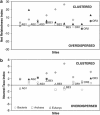Microbial community structure across the tree of life in the extreme Río Tinto
- PMID: 20631808
- PMCID: PMC3105667
- DOI: 10.1038/ismej.2010.101
Microbial community structure across the tree of life in the extreme Río Tinto
Abstract
Understanding biotic versus abiotic forces that shape community structure is a fundamental aim of microbial ecology. The acidic and heavy metal extreme Río Tinto (RT) in southwestern Spain provides a rare opportunity to conduct an ecosystem-wide biodiversity inventory at the level of all three domains of life, because diversity there is low and almost exclusively microbial. Despite improvements in high-throughput DNA sequencing, environmental biodiversity studies that use molecular metrics and consider entire ecosystems are rare. These studies can be prohibitively expensive if domains are considered separately, and differences in copy number of eukaryotic ribosomal RNA genes can bias estimates of relative abundances of phylotypes recovered. In this study we have overcome these barriers (1) by targeting all three domains in a single polymerase chain reaction amplification and (2) by using a replicated sampling design that allows for incidence-based methods to extract measures of richness and carry out downstream analyses that address community structuring effects. Our work showed that combined bacterial and archaeal richness is an order of magnitude higher than eukaryotic richness. We also found that eukaryotic richness was highest at the most extreme sites, whereas combined bacterial and archaeal richness was highest at less extreme sites. Quantitative community phylogenetics showed abiotic forces to be primarily responsible for shaping the RT community structure. Canonical correspondence analysis revealed co-occurrence of obligate symbionts and their putative hosts that may contribute to biotic forces shaping community structure and may further provide a possible mechanism for persistence of certain low-abundance bacteria encountered in the RT.
Figures




Similar articles
-
Prokaryotic community structure in algal photosynthetic biofilms from extreme acidic streams in Río Tinto (Huelva, Spain).Int Microbiol. 2008 Dec;11(4):251-60. doi: 10.2436/20.1501.01.69. Int Microbiol. 2008. PMID: 19204897
-
Comparative microbial ecology of the water column of an extreme acidic pit lake, Nuestra Señora del Carmen, and the Río Tinto basin (Iberian Pyrite Belt).Int Microbiol. 2014 Dec;17(4):225-33. doi: 10.2436/20.1501.01.225. Int Microbiol. 2014. PMID: 26421738
-
Microbial community structure in the North Pacific ocean.ISME J. 2009 Dec;3(12):1374-86. doi: 10.1038/ismej.2009.86. Epub 2009 Jul 23. ISME J. 2009. PMID: 19626056
-
Lessons learned from thirty years of geomicrobiological studies of Río Tinto.Res Microbiol. 2016 Sep;167(7):539-45. doi: 10.1016/j.resmic.2016.06.001. Epub 2016 Jun 24. Res Microbiol. 2016. PMID: 27349346 Review.
-
Prokaryotic and eukaryotic diversity in hydrothermal continental systems.Arch Microbiol. 2021 Sep;203(7):3751-3766. doi: 10.1007/s00203-021-02416-1. Epub 2021 Jun 18. Arch Microbiol. 2021. PMID: 34143270 Review.
Cited by
-
Microbial community potentially responsible for acid and metal release from an Ostrobothnian acid sulfate soil.FEMS Microbiol Ecol. 2013 Jun;84(3):555-63. doi: 10.1111/1574-6941.12084. Epub 2013 Feb 26. FEMS Microbiol Ecol. 2013. PMID: 23369102 Free PMC article.
-
Relative Roles of Deterministic and Stochastic Processes in Driving the Vertical Distribution of Bacterial Communities in a Permafrost Core from the Qinghai-Tibet Plateau, China.PLoS One. 2015 Dec 23;10(12):e0145747. doi: 10.1371/journal.pone.0145747. eCollection 2015. PLoS One. 2015. PMID: 26699734 Free PMC article.
-
Comparative metagenomic and metatranscriptomic analyses of microbial communities in acid mine drainage.ISME J. 2015 Jul;9(7):1579-92. doi: 10.1038/ismej.2014.245. Epub 2014 Dec 23. ISME J. 2015. PMID: 25535937 Free PMC article.
-
Millimeter-scale patterns of phylogenetic and trait diversity in a salt marsh microbial mat.Front Microbiol. 2012 Aug 10;3:293. doi: 10.3389/fmicb.2012.00293. eCollection 2012. Front Microbiol. 2012. PMID: 22908010 Free PMC article.
-
Influence of sedimentary deposition on the microbial assembly process in Arctic Holocene marine sediments.Front Microbiol. 2023 Aug 28;14:1231839. doi: 10.3389/fmicb.2023.1231839. eCollection 2023. Front Microbiol. 2023. PMID: 37700860 Free PMC article.
References
-
- Aguilera A, Zettler E, Gomez F, Amaral-Zettler L, Rodriguez N, Amils R. Distribution and seasonal variability in the benthic eukaryotic community of Rio Tinto (SW, Spain), an acidic, high metal extreme environment. Syst Appl Microbiol. 2007;30:531–546. - PubMed
-
- Amaral-Zettler LA, Gómez F, Zettler E, Keenan BG, Amils R, Sogin ML. Eukaryotic diversity in Spain's River of Fire. Nature. 2002;417:137. - PubMed
-
- Amils R, Gonzalez-Toril E, Fernandez-Remolar D, Gomez F, Aguilera A, Rodriguez N, et al. Extreme environments as Mars terrestrial analogs: the Rio Tinto case. Planet and Space Sci. 2007;55:370.
-
- Amils R, Gonzalez-Toril E, Fernandez-Remolar D, Gomez F, Rodríguez N, Duran C. Interaction of the sulfur and iron cycles in the Tinto River ecosystem. Rev Environ Sci Biotechnol. 2002;1:299–309.
-
- Amils R, Gonzalez-Toril E, Gomez F, Fernandez-Remolar D, Rodríguez N, Malki M, et al. 2004Importance of chemolithotrophy for early life on earth: the Tinto River (Iberian Pyritic Belt) caseIn: Seckbach J (ed).Origins Kluwer Academic Publishers: Netherlands; 463–480.

